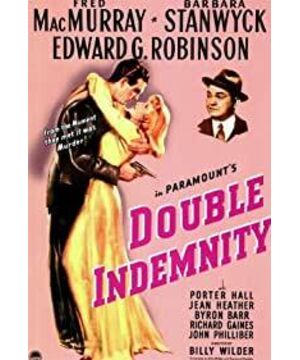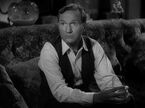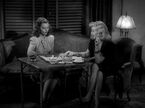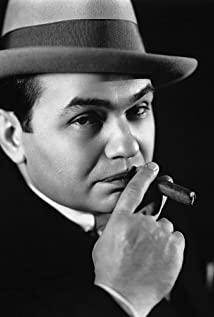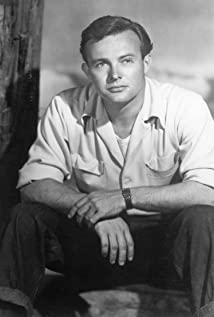Has always been disinterested in Billy Wilder's movies, neither liked nor disliked it, with an average score of 3 stars. For me, his films are too severely controlled and constrained by the script. The superb lines and story structure only further functionalize and instrument the characters, weaving them into a network of detailed plots, using them instead of shaping them. Especially when compared with the noir films of Orson Welles, Fritz Lang or Howard Hawks, Wilder's films have a weak atmosphere, lack of passion and energy, and despite their efforts to cover textual "sarcasm" and "fables", the images are relatively lacking in accomplishments. Of course I prefer "movie writers" to script writers like him.
But when watching "Double Compensation", one of the shots rarely aroused my interest:
In the movie, the victim's Dietrichson's wife Phyllis (left) and insurance salesman Walter Neff (middle) are accomplices and accomplices, while the latter's friend and claims investigator Barton Keyes (right) is trying to detect this murder case disguised as an accident . The scene of the three of them in the same frame reveals the extremely tight triangular confrontational relationship implied in the scene.
As the two most talented film noir screenwriters in Hollywood, Wilder and his partner Raymond Chandler used very clever screenwriting and narrative skills to achieve this scene. In the previous scene, the film told us humorously that Keyes believed that Dietrichson's death was an accident and refuted the "suicide fraud" theory face to face. As the real murderer, Walter had always worried that Keyes' experience and wisdom would be enough to dismantle his strategy, but he was relieved to see that his friend was completely kept in the dark, thinking that the difficulties were over. As a result, as Keyes' mood changes, the film has also entered a relaxed tone. The audience originally expected that the two people's murder and insurance scheme would not go so smoothly, and this breaking-expected result became the first turning point in this paragraph.
When Walter got home, he received a call from Phyllis, reported to her the smooth progress of the matter, and invited her to come to the house to celebrate. As soon as Walter hung up the phone, the doorbell rang, and the second turning point came. The audience immediately understood that the visitor could never be Phyllis-she couldn't have come so fast, who was still on the phone just a block away. The door opened, and behind the door stood Keyes in deep thought. Here, the film twice used the previous "broken leg" foreshadowing, which made Keyes discover the suspicious point of "perfect murder".
But beyond that, the second turning point also produced more effects. While Keyes and Walter were talking in Walter's house, there was a clock outside the scene that continued to run-the countdown to Phyllis' arrival here. From the content of the previous phone call, we know that she is coming here from a block away, knowing nothing about Keyes' visit. Her appearance will undoubtedly become a show of complicity with Walter.
Here, the movie does not use parallel editing to show these two parallel plots at the same time, creating a classic "last minute rescue", but always stays in the scene of the first plot, only sustained by Walter's continuous nervous expression. It reminds the existence and progress of another plot. From this point of view, Phyllis’s role in this scene is equivalent to what Hitchcock called "under the table bomb". As an invisible but confirmed dangerous object, it will explode at any time and explode. The moment of —— the moment when the knock on the door sounds — as unobservable but predictable information, is becoming the suspense of the movie.
The plot continues. Phyllis heard the conversation inside the house and did not enter the door rashly. Keyes happened to be about to leave, and Phyllis hurriedly hid behind the door.
So, the lens mentioned at the beginning of this article appeared. In this shot, although the "bomb under the table" did not explode due to Phyllis' wit, it did not disappear, but continued to exist in the scene.
This lens uses a longer focal length, so although the longitudinal space of the corridor is clearly divided into three levels by the physical furnishings (open doors) and the position of the characters, they do not have a strong sense of perspective with each other. Therefore, the flat, regular geometric composition dominates the visual perception of this lens, and this is also the most interesting part of it.
On the left side of the lens, in the foreground closest to the camera, is Phyllis hiding behind the door. She is the "under the table bomb" that will explode in this scene and this scene at any time, and it is also a secret that Walter, as the owner of the scene, must hide. And to the right of the camera, in the deepest part of the corridor, is Keyes who is about to leave. If Phyllis is a bomb, then Keyes is a detonator, because only after Keyes sees Phyllis, the bomb will detonate and the strategy will be revealed. And Walter, caught between the two, is like a mediator and bomb destroyer who walks on thin ice. He must carefully circulate between the two, separating the detonator and the bomb in the background and the foreground, and keep them out of contact.
From the conversation between Walter and Keyes in the room, to the scene of the three people in the same frame, the "bomb under the table" not only persists, but also has been upgraded and materialized from front to back. In the former, the bomb is invisible; in other words, it is only visible in the form of plot information, not visual entities. In the latter, the bomb is visible, in the same frame as the detonator and the bomb disposal person.
Therefore, the suspense of the former comes more from the fear of the suddenness of bomb explosions (the time of explosion is unknown). (Explosion at a certain moment), the synergy between the two makes the crisis not limited to the moment it occurs, but spreads into the entire period of waiting for the crisis in a potential way; its power does not only come from the explosion, but from Fear of explosions.
In fact, the "bomb" is the same as the general plot transition mentioned earlier, and its establishment must be based on the audience's conscious expectations of the movie: the information premise of "bomb existence" is given in exchange for the expectation of "bomb explosion". "Bomb under the table" is a kind of information manipulation technique, a kind of narrative deception that tricks the audience into fearing their own fears.
If the "bomb" set in "Double Compensation" only exists in the narrative dimension, it is not enough to be such a big book. But in the latter, that is, the scene where the three people are in the same frame, the bomb is no longer a plot information or a narrative concept, but a part of the image. Here, not only the "bomb existence" as the "inevitability" is visualized, but also the "probability" as the "bomb will explode at a certain moment" is also visualized. Where is it reflected? It's the door from the left side of the camera to the center line, the door that was opened and ready to move.
The door is a two-way switch. When it is closed, it is a barrier, a sign of division, closing a space and separating two spaces; and when it is open, it becomes a vent to the space and a channel to the inside. But what if we don’t follow the rules for the use of doors and use the open door as a barrier instead of the closed door?
The door hinge is an unstable connecting component, which exists to create and carry movement (rotation), not to fix it. Therefore, an open door that is not restricted by locks and bolts, although it has the opaque properties of the door and can be used to block the line of sight, but does not have the stable properties of the door-it must be firmly grasped by the hand , Can barely remain still, otherwise it will turn at any time and immediately reveal everything hidden behind it.
From this perspective, the opened door is a kind of refuge that cannot be trusted. The more you hide, the more fear-not only the look behind the door, but also the possibility of the door turning. An open door, or a door that is fixed at an angle but capable of turning, is a perfect symbol of the probability that "bombs may explode."
Not only that, the open door serves as a barrier, not only unstable, untrustworthy, but also incomplete. A closed door, together with the entire room it closes, forms a black box with no tight joints, which wraps and shields people and objects in all directions. The function of the door is to cut off the final passage; and one opens in the corridor. The door is just a thin piece of wood that can only cover one person's body. It can only shield the line of sight within a certain angle and a certain area.
In this shot, it is precisely because of such incomplete obscuration that the open door divides the entire shot into two parts: the left side is the space behind the covered door, and the right side is the open deep corridor space. Phyllis, who was hiding behind the door, could not move. The most active action she could make was to try to keep herself and the door still; on the contrary, the corridor where Keyes was located in the distance happened to herald a power to move around. The movement is two-way, possibly backwards and forwards: backward means the safety of Phyllis, and the possibility of forward, like the detonator close to the bomb, releases a dangerous and disturbing signal.
If Phyllis is an informed but passive hider, and Keyes is an active but unknowing seeker, then only Walter in the middle of the screen has the power to act proactively and has control over all the situations in the scene. Therefore, it is logical for him to act as a mediator of the conflict between the foreground and the background, and a bomb destroyer. Sure enough, Keyes walked forward and toward the open door, and Walter stepped forward in time, lit his cigar, and let the real crisis resolve into a "fantasy shot."
The bomb threatening this scene was finally dismantled, and the action of dismantling was exactly the core clue repeated many times before and after "Double Compensation": the match lighted the cigarette.
View more about Double Indemnity reviews


